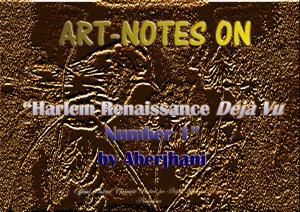Artwork by Aberjhani along with books by him will be available for purchase as part of his participation in Local Author Day on March 24, 2024, in Lafayette Square in the city of Savannah, Georgia (USA). Much of the artwork on display for the event will reflect themes explored in his books on Savannah.

The Harlem Renaissance is celebrated around the world as one of the most important cultural and political periods in African-American and American history. Next year, 2019, celebrations will get underway to mark the 100th anniversary of the Renaissance.
You might say that I started my own celebration of the Harlem Renaissance Centennial with the publication of both Encyclopedia of the Harlem Renaissance (2003 and 2010), and The Wisdom of W.E.B. Du Bois (new eBook edition due out July 31, 2018) followed by launch of the 100th Anniversary of the HR Initiative in 2011. It was probably inevitable once I started producing images that I would tackle tributes in this medium as well. But my aim is not just to salute the past. It is to help safeguard an irreplaceable legacy by adding contributions which hopefully will inspire modern sensibilities to learn more about it and join in on celebrations of the centennial. So please: accept this as YOUR INVITATION.
Many tend to identify the highlight of the Harlem Renaissance as a period lasting from 1919-1929 with events centered primarily in Harlem, New York, USA. But when studying the continued productivity of artists and writers associated with the era, and looking at "spin-offs" that took place in different American cities, it becomes obvious that the 20s were only the beginning of a movement which adapted and evolved for at least two more decades.
The artists of the Harlem Renaissance were essential to American history because their works formed a significant psychological bridge which made it possible for African-Americans and Americans in general to make the difficult transition from the cultures of slavery, reconstruction, and neo-slavery to the progressive social actions of later decades.
Among the most celebrated of these artists were: Aaron Douglas, Lois Mailou Jones, Augusta Savage, Jacob Armstead Lawrence, Elizabeth Catlett, Romare Beardon, and numerous others. Their work, like that of literary counterparts such as Claude McKay and Dorothy West, often struck a fine balance between political propaganda and individual expression.
One of the most important gifts contributors to the Harlem Renaissance gave the world was an enduring strategy for refining the practice of democracy. They painted, sculpted, wrote, danced, sang, marched, taught, and kept striving at a time when Blacks were routinely lynched for not appearing subservient enough, or, for posing what was perceived of as an economic threat. Their everyday courage and commitment to creative civilized responses to sanctioned brutality was remarkable.
Aberjhani
©July 2018